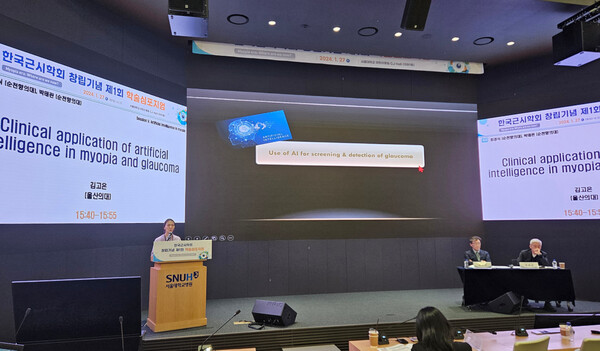Medical artificial intelligence (AI) is bringing new possibilities to diagnosing and predicting myopia, or nearsightedness.
Some studies have shown that it can rival ophthalmologists in diagnosis, with some experts emphasizing the need for more aggressive and diverse attempts to deal with severe myopia, which can lead to blindness.

On Saturday, the Korean Society for Myopia held its inaugural symposium at the Seoul National University Hospital, focusing on the possibility of using medical AI in the field of “pathologic myopia,” with the attendance of about 200 experts and specialists.
Myopia is one of the fastest-growing diseases in the world. Its complications include macular degeneration, retinal detachment, glaucoma, and cataracts. It can lead to decreased vision and even blindness. Korea has recorded the fastest-growing number of myopia patients. The medical community estimates that between 80 percent and 90 percent of young Koreans have myopia.
However, there is still no clear way to predict the prognosis of myopia accurately. The mechanism by which myopia leads to glaucoma is also "almost unknown." That's why experts are pinning their hopes on medical AI. Recent studies have shown that AI's diagnostic performance is comparable to that of ophthalmologists.
"In pathological myopia, research is underway to detect or segment lesions automatically, including screening using fundus photographs and classification of pathological myopia stages using light interference," said Dr. Cho Bum-joo, professor of ophthalmology at Hallym University College of Medicine.
Furthermore, another research is underway to predict the future visual prognosis of patients with high myopia and the response to myopic neovascularization treatment, Professor Cho said, adding that although AI cannot be called a panacea, it is expected to serve as a tool to deal with myopia progression.
Kim Ko-eun Kim, professor of ophthalmology at the University of Ulsan College of Medicine, said, "Data automation and precision can enable faster screening and diagnosis, as well as warning doctors of missed factors. Recently, there have been an increasing number of studies in the field of glaucoma that attempt to predict the likelihood of onset or progression."
However, efforts to reinvigorate research have been slow compared to the level of AI technology and its potential for application.
"It is important to identify whether a patient has glaucoma or not, but no less essential is a system that quantifies the likelihood of progression to glaucoma and the degree of fatality and predicts the prognosis," Professor Kim said. "However, research for this area is lacking in AI-related research."
Even in glaucoma-related AI research, there have been fewer studies on glaucoma accompanied by myopia, saying, “Studies within the category of glaucoma have been conducted more than those with myopia.”
"Although the AI’s diagnosis is almost as good as that of a human doctor, there is still the problem of poor image quality or poor results if the disease is not prominent," Kim said. “There is also a lack of a 'gold standard' for AI training, showing the need for more active discussions and attempts."

